How Exercise Can Help Build Physical — and Mental — Resilience
“Resilience is the ability to recover from stress quickly and efficiently, and secondly to have a higher threshold for stress so you can successfully deal with a lot more,” says Jenny Evans, author of The Resiliency Revolution.
Resilience isn’t reserved for a select few who naturally adapt well in the face of adversity, trauma, tragedy, threats, or other significant sources of stress. Everyone can become more resilient to the stress of all kinds.
That’s because this remarkable capacity is trainable: You can learn not only to survive and manage stress but also to grow and improve in response to it.
“It is not a personality flaw to feel really stressed or feel like you’re not very resilient,” says Evans. “That is not a personal shortcoming. That is 100 percent straight-up chemistry and biology, and that is what your brain and body are hardwired to do. In a way, if you’re struggling with stress, good. It means your brain is actually doing its job. Now let’s find a way for you to handle it before the physiological stress response gets triggered.”
Resilience training is a big ask. It suggests pushing your physical limits, in some way, almost daily. You could sum it up in one phrase: “Do the stuff you don’t feel like doing.”
That probably doesn’t sound like much fun — but that’s exactly the point. If our attachment to creature comforts has done a number on our resilience, it makes sense that the way back is to occasionally detach deliberately from them.
The way out may not be easy, says Nelson, but in principle, it’s fairly simple: “Practice doing hard stuff.”
Ready to get uncomfortable? These ideas can help you get started.
Find Your Strength
Lifting weights can be a powerful way to foster resilience because it involves believing in oneself, says clinical social worker and trauma specialist Mariah Rooney, MSW, LICSW, the cofounder of Trauma Informed Weight Lifting, a program that teaches fitness professionals how to use resistance exercise as a tool for overcoming mental-health challenges.
“For some folks who have experienced trauma, the body can be a scary place to be and connect with,” she says. “Weightlifting can be one way of engaging our bodies that allows us to expand our window of tolerance and have powerful experiences of agency and strength when perhaps our bodies have been the holders of our painful experiences.”
At the same time, the progress many lifters experience offers encouraging evidence that growth is possible and that effort yields results — in the gym as well as in other areas of life. “Weightlifting fosters self-trust,” says Rooney. “Every time you approach the barbell, there’s a question mark: Can I do this? Will it feel good? Do I feel safe? And every rep becomes an opportunity to learn to listen to and respond to ourselves in more attuned ways.”
As we accrue more successful lifts, our capacity to grow from stress is reinforced.
Rooney has discovered that those little weightlifting triumphs can be an empowering metaphor for people struggling with psychological burdens. “The physical strength they build translates into a greater sense of efficacy in their relationships and other aspects of their lives,” she says.
Building resilience in the weight room takes some finesse, however. The wrong workout — too much weight, too many reps — can break you down physically rather than build you up. Similarly, the wrong environment can stress you out rather than calm you down.
A key to training for resilience is to stay flexible and tuned in. “It can be helpful to adjust a routine — even throw it out altogether — when necessary,” Rooney says, “particularly when our bodies are letting us know that we need something different.” She suggests that people seeking resilience take one step beyond the fitness axiom “Listen to your body”: “Pay attention to your emotional and psychological state, too.”
Find Your Breath
Resistance training isn’t the only physical path to greater resilience. The “instructive discomfort” of an asana practice can also help you get there, says yoga and martial-arts instructor Stephen Schilling.
“You can confront that discomfort in one of two ways: Draw away from it, or breathe through it and accept it. That’s what allows you to endure,” Schilling explains. “The discomfort doesn’t necessarily go away. But you learn that it won’t break you. You discover you can live with it to a greater extent than you thought.”
Contained within that simple process — breathing through discomfort — is a powerful life lesson: Practice yoga long enough and you can learn to manage your response to life’s disappointments and worries. “Your time on the mat gives you a reference point,” he says. “You can say, ‘I got through my workout this morning; I can get through this.’”
Cardiovascular exercise can produce a similar effect: In addition to improving circulation and strengthening your heart and lungs, steady-state cardio — think jogging, cycling, vigorous hiking — encourages deep, steady breathing, which helps stimulate the stress-relieving, parasympathetic, rest-and-digest system.
Find Your Intensity
High-intensity interval training (HIIT) is yet another potent physical approach to building resilience.
HIIT — which describes a style of exercise rather than a specific activity, sport, or movement style — can include strength and cardio moves. And by design, HIIT workouts are brief, making them accessible to those who are short on time or who lack the motivation for a longer session.
“It takes just 30 to 60 seconds of high-intensity physical activity to produce endorphins, so HIIT is your in-the-moment resiliency solution. Like, boom! You just hit the reset button,” says Evans.
“Then, when you string together these short bursts of activity for 10 or 20 minutes, and over time string together these short workouts, you increase your level of fitness and raise your threshold for stress,” she explains.
If you prefer body-weight moves to traditional cardio, Evans suggests making a list of five to 10 exercises, grabbing a deck of cards, and pulling cards every round to dictate how many reps to perform. (Evans, who is also a certified personal trainer, has developed a training tool called Hit the Deck, a set of 35 exercise cards along with a programmable interval timer.)
“Whether it’s cardio or strength — as long as it’s making you uncomfortable, it’s making you more resilient,” Nelson says.
And if high-intensity work simply isn’t for you, don’t stress about it. The same 2017 study showed that steady-state training (longer workouts performed at lower intensity) could also improve glucose metabolism — suggesting that either approach is effective when your goal is tuning up your carb-burning engine.
Movement for Body and Mind
Exercise is probably the most widely practiced strategy for boosting physical resilience. When you work out, you subject your muscles to stress; work hard enough and some of the muscle fibers fray and break. In the hours and days after your workout, your body repairs those broken fibers, laying down extra reinforcement to protect your muscles against similar stress in the future.
Repeat the same exercise session a few days later, and continue that process for weeks or months, and you’ll be measurably stronger, faster, and more muscular. Your muscles are now better able to handle challenging loads.
“If there is a fountain of youth, it is regular exercise.”
Your bones are stronger and less likely to break. Your body is better able to clear waste products from your muscles, so that burning feeling doesn’t come on as quickly or acutely. Your heart pumps more blood more easily, so you don’t get as winded. Your nervous system is more efficient, so the movement is smoother and easier.
That is resilience at work, and it’s woven so completely into our physiology that it continues to function into old age. Research has shown that nonagenarians get predictably stronger and fitter from a consistent exercise routine.
“If there is a fountain of youth, it is regular exercise,” says geriatrician Edmund Lew, MD. “It enhances the function of the cellular, metabolic, and organ systems of the body.” This includes the immune, vascular, and nervous systems, translating into better movement, cognition, and emotional stability.
The Resilience Workout
Bad news first: You can’t entirely prevent injuries. The inevitability of the odd ankle twist or lower-back torque when you’re working out or just living life makes complete prevention a pipe dream.
What is possible, says strength coach Dan John, is to gain an edge over the slower forces that threaten to erode your resilience in the long term — things like muscle loss, joint instability, and weakness in the core. “Those are the things that get you down as you age,” he says.
John designed the following four-week workout routine to help ward off the age-related decline and frailty that many consider inevitable. These five moves can help preserve — and even increase — muscle mass; teach you to stabilize your core, keeping your spine safe; and fire up your glutes, build grip strength, and address other neglected areas that directly affect longevity.
Commit to holding the line on those things, and you’ll have a better chance of emerging unscathed from life’s bigger mishaps.
The Workout
Perform the workout up to four times a week on nonconsecutive days. Always choose a weight — or variation — that makes the move challenging on your final few reps. For example, you’ll use more weight in week 2 when you’re doing sets of five reps than you used in week 1 with sets of eight.
1. Half-Kneeling Press
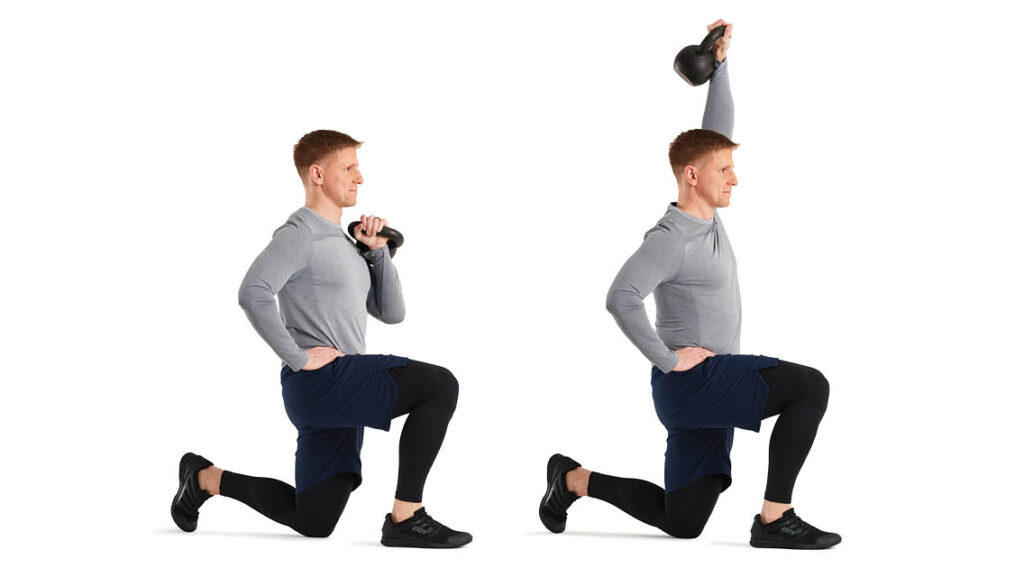
- Holding a dumbbell or kettlebell at shoulder height in your right hand, assume a half-kneeling position, with your right knee on the floor and your left foot standing in front of you.
- With your torso braced and upright, exhale strongly as you press the weight from shoulder height to a locked-out position overhead.
- Slowly inhale as you lower the weight to the starting position.
- Repeat for reps, then perform the same number on the other side.
| Week 1: | Three sets of eight reps. |
| Week 2: | Five sets of five reps. |
| Week 3: | 25 reps total, breaking up the reps into as many sets as you need. |
| Week 4: | Same rep scheme as Week 1. |
2. Suspension-Trainer One-Arm Rows
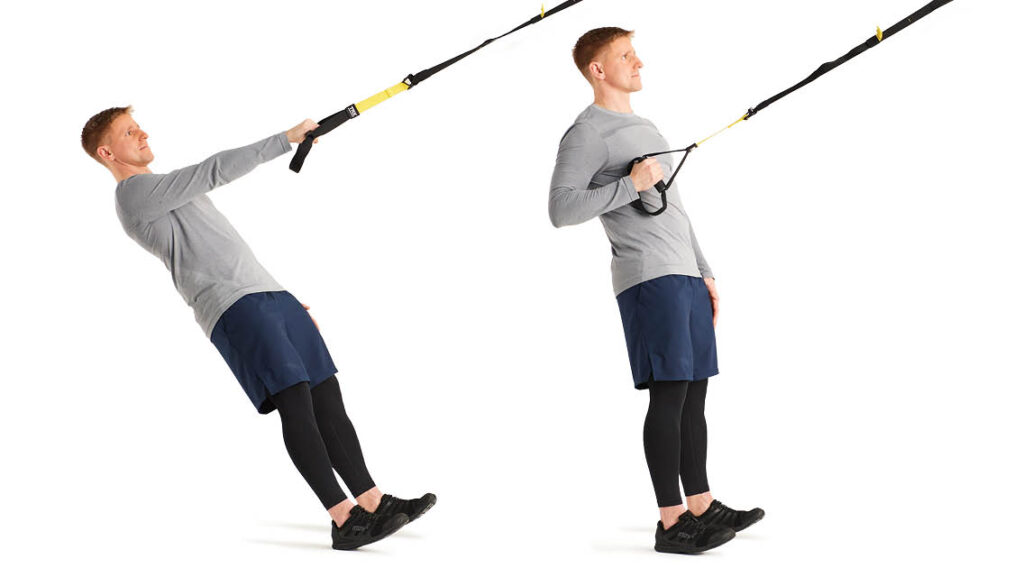
- Holding one of the handles of a TRX or equivalent in your right hand, face the anchor point and walk back to create some tension on the band.
- Keeping your body straight and your shoulders and hips square, walk your feet forward to increase the load (the farther forward you place your feet, the tougher it will be).
- Place your left hand behind your back and keep it there throughout the set.
- Keeping your gaze on the anchor point, pull yourself upward by retracting your shoulder blade and bending your right arm, keeping your elbow close to your side throughout the movement.
- Reverse the move, slowly lowering yourself back to the starting point.
- Repeat for reps, then switch sides and perform the same number with your left hand.
| Week 1: | Three sets of eight reps. |
| Week 2: | Five sets of five reps. |
| Week 3: | 25 reps total, breaking up the reps into as many sets as you need. |
| Week 4: | Same rep scheme as Week 1. |
3. Goblet Squat
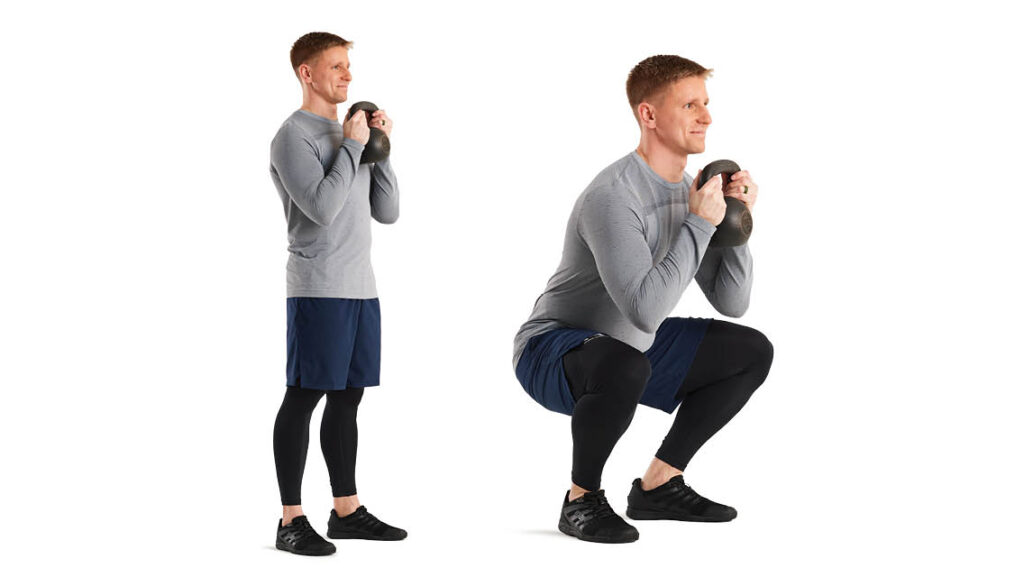
- Hold a kettlebell in both hands by the horns — the two base points of the handle — against your chest just under your chin (you can also hold a single dumbbell, vertically, against your chest in the same manner).
- Assume a shoulder width stance with your toes turned slightly out.
- Keeping your lower back in its natural arch, your chest up and out, slowly bend at your knees, ankles and hips, sitting down as far as you can while keeping your back flat.
- Pause in the low position, reverse the movement, and repeat for reps.
| Week 1: | Three sets of eight reps. |
| Week 2: | Five sets of five reps. |
| Week 3: | 25 reps total, breaking up the reps into as many sets as you need. |
| Week 4: | Same rep scheme as Week 1. |
4. Glute Bridge
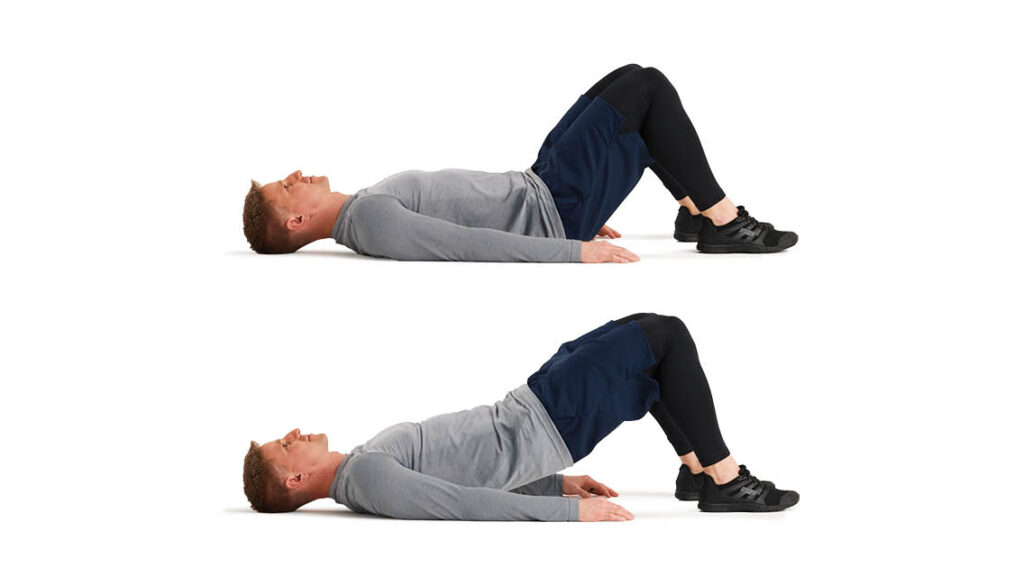
- Lie on your back with your knees bent and your feet flat and shoulder-width apart.
- Tuck your pelvis and push through your feet, raising your hips as high as you can.
- Contract your glutes as hard as you can and hold for a one-count.
- Slowly lower yourself, stopping just before your sacrum is on the floor, and repeat.
| Week 1: | Three sets of 10. |
| Week 2: | Three sets of 12. |
| Week 3: | Three sets of 15. |
| Week 4: | Four sets of 15. |
5. Suitcase Carry
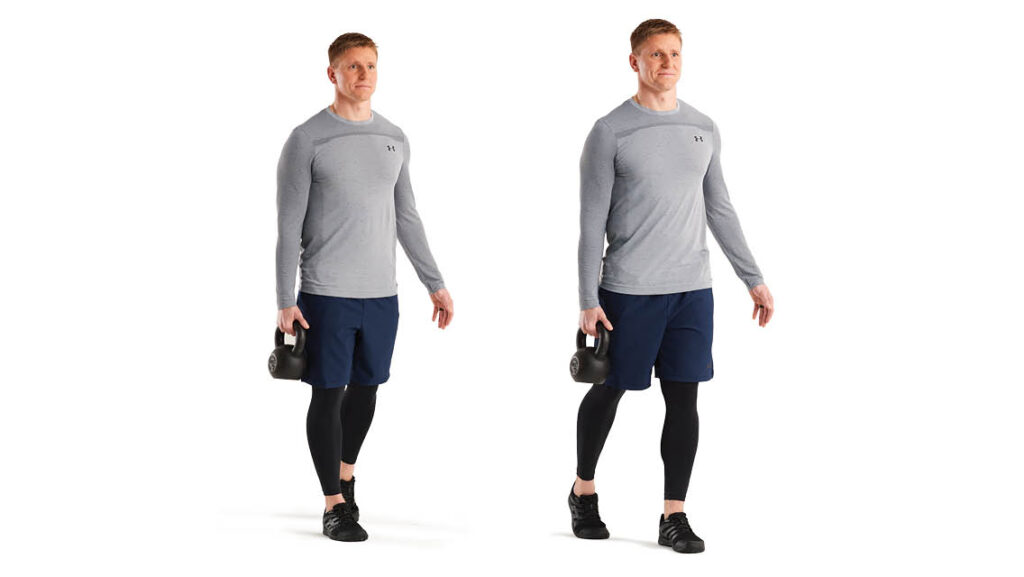
- Hold a heavy dumbbell or kettlebell by your side in your left hand.
- Maintaining excellent posture (chest up, shoulder blades on your back, head stacked over your spine), walk forward for 20 to 60 seconds. No space? March in place.
- Switch hands and repeat for about the same time frame (you can also count steps: go for double the number of seconds indicated — so if you’re trying to hit 20 seconds, take 40 steps).
- Change the duration of each set week to week according to the following parameters:
| Week 1: | 45 seconds/side, 3 sets. |
| Week 2: | 60 seconds/side, 2 sets. |
| Week 3: | 20 seconds/side, 4 sets. |
| Week 4: | Week 4: 15 seconds/side, 3 sets. |
Get top quality fitness, gym, exercise and sport equipment in Nigeria from Gategold Fitness. With branches in Surulere (Lagos), VGC (Lagos), Jabi (Abuja), Wuse (Abuja), Onitsha and Port Harcourt. Hotlines: 08033293090, 08090926122, 08032258018.
Share this content:






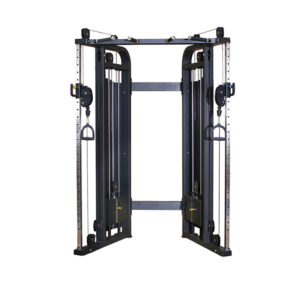
2 comments